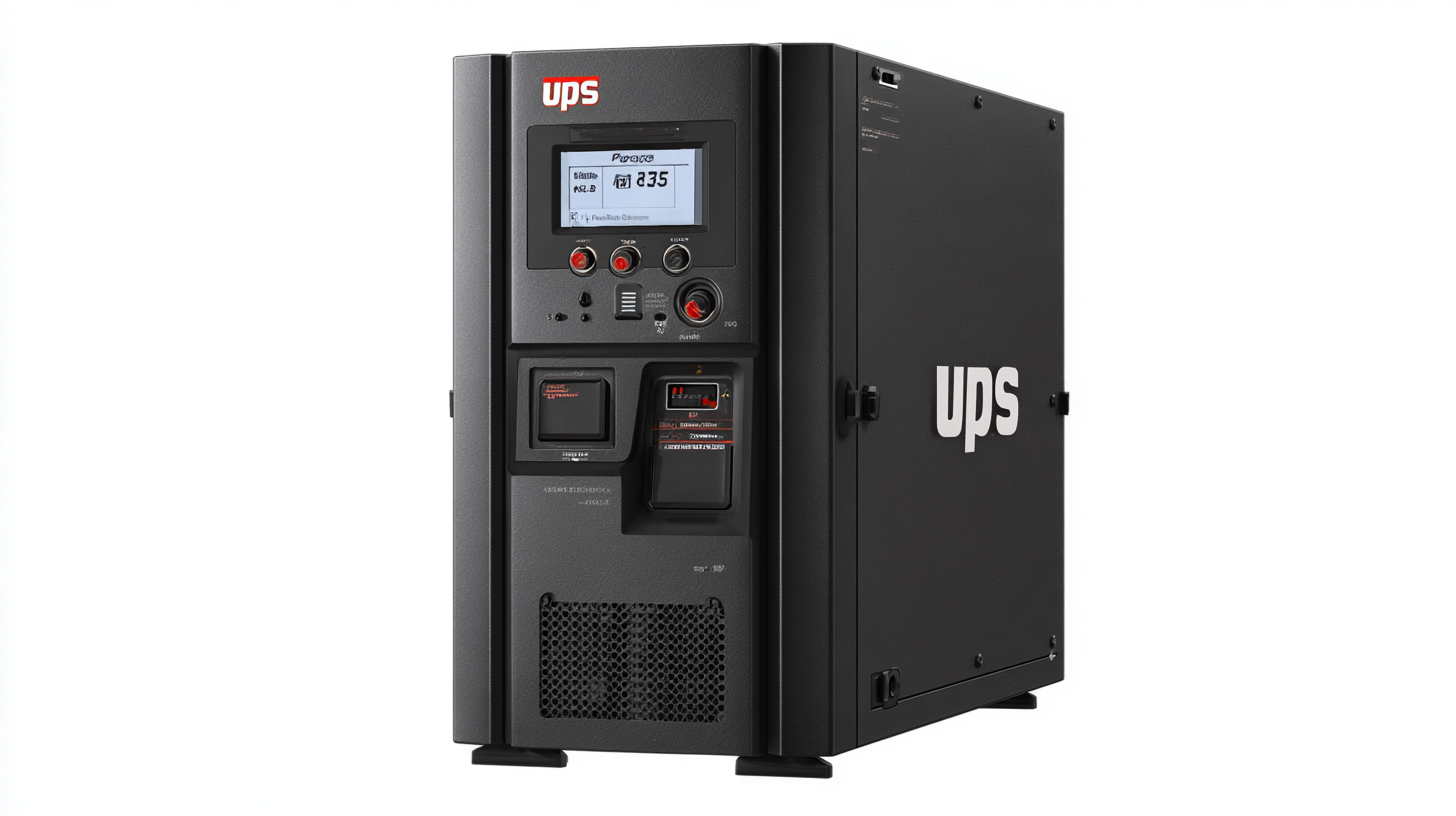Blog
Understanding the Technical Specifications of Best Ups Power for Optimal Performance
In the modern digital age, ensuring consistent power supply is crucial for both personal and professional environments, making understanding UPS power specifications more important than ever.
 Uninterruptible Power Supplies (UPS) are essential devices that provide backup power during outages, protect equipment from power surges, and ensure uninterrupted operations. However, not all UPS systems are created equal; choosing the right one hinges on grasping various technical specifications, including capacity, runtime, inverter efficiency, and more. This guide aims to demystify these key specifications, enabling consumers to make informed decisions tailored to their specific needs.
By exploring the intricacies of UPS power, we will help you optimize performance, enhance equipment longevity, and safeguard your critical data against unexpected power interruptions. Whether you're selecting a UPS for home use or for a large-scale enterprise, understanding these technical details is the first step towards achieving reliable power management.
Uninterruptible Power Supplies (UPS) are essential devices that provide backup power during outages, protect equipment from power surges, and ensure uninterrupted operations. However, not all UPS systems are created equal; choosing the right one hinges on grasping various technical specifications, including capacity, runtime, inverter efficiency, and more. This guide aims to demystify these key specifications, enabling consumers to make informed decisions tailored to their specific needs.
By exploring the intricacies of UPS power, we will help you optimize performance, enhance equipment longevity, and safeguard your critical data against unexpected power interruptions. Whether you're selecting a UPS for home use or for a large-scale enterprise, understanding these technical details is the first step towards achieving reliable power management.
Impact of UPS Power Quality on Equipment Performance and Longevity
 The quality of Uninterruptible Power Supply (UPS) power plays a crucial role in determining the overall performance and longevity of connected equipment. Fluctuations in voltage, frequency variations, and harmonic distortion can adversely affect sensitive electronic devices. For instance, a UPS that delivers clean and stable power not only protects equipment from sudden outages but also minimizes risks associated with power surges and sags. This ensures that devices operate under optimal conditions, ultimately reducing wear and tear over time.
The quality of Uninterruptible Power Supply (UPS) power plays a crucial role in determining the overall performance and longevity of connected equipment. Fluctuations in voltage, frequency variations, and harmonic distortion can adversely affect sensitive electronic devices. For instance, a UPS that delivers clean and stable power not only protects equipment from sudden outages but also minimizes risks associated with power surges and sags. This ensures that devices operate under optimal conditions, ultimately reducing wear and tear over time.
Moreover, high-quality UPS systems are equipped with advanced features such as automatic voltage regulation and power conditioning. These features work to improve the electrical environment by filtering out noise and stabilizing the voltage, thus allowing machinery to function seamlessly. Businesses investing in superior UPS technology benefit from extending the lifespan of their equipment and reducing maintenance costs. Consequently, selecting the right UPS is not just about backup power but also about preserving the integrity and efficiency of vital operations.
Key Technical Specifications for Selecting UPS Systems for Industrial Applications
When selecting a UPS (Uninterruptible Power Supply) system for industrial applications, understanding the key technical specifications is crucial for optimal performance. One of the most significant specifications is the capacity rating, typically expressed in Volt-Amperes (VA) or kilovolt-amperes (kVA). This rating indicates how much power the UPS can handle, and it's important to choose a unit that can support your total load requirements without exceeding its capacity.
Tip: Always calculate the total wattage of the equipment you’ll be connecting to the UPS. This figure should be well within the UPS's capacity to ensure reliable performance and longevity.
Another critical specification to consider is the backup time, which indicates how long the UPS can provide power during an outage. This varies between different models and depends heavily on the load connected. For industrial operations where downtime can be catastrophic, choosing a UPS that offers adjustable backup times can provide greater flexibility in addressing specific operational needs.
Tip: Assess your facility's power outage history and plan for longer backup times to account for unexpected disruptions. It’s beneficial to have a UPS with scalable battery options for future demands.
Understanding the Technical Specifications of Best UPS Power for Optimal Performance - Key Technical Specifications for Selecting UPS Systems for Industrial Applications
| Specification | Description | Value |
|---|---|---|
| Capacity | Power output capacity of the UPS | 10 kVA - 500 kVA |
| Input Voltage Range | Accepted input voltage range for operation | 160V - 300V |
| Output Voltage | Standard output voltage during operation | 220V/230V/240V |
| Battery Type | Type of battery used in the UPS | Sealed Lead Acid (SLA) / Lithium-Ion |
| Runtime | Duration the UPS can provide power during an outage | 5 min - 120 min |
| Efficiency | Percentage of power converted from input to output | 90% - 98% |
| Form Factor | Physical configuration of the UPS | Tower / Rack-mounted |
Understanding Compliance Standards for UPS Systems in Global Markets
In today's rapidly evolving global markets, the compliance standards for Uninterruptible Power Supply (UPS) systems have become more crucial than ever. With the surge in demand for energy-efficient solutions, particularly in sectors like data centers in Australia, businesses must navigate complex regulatory landscapes while striving for optimal performance. Ample attention must be paid to compliance specifications, as they ensure that UPS systems can operate effectively under stringent industry regulations.

Tips:
1. Regularly review and understand the specific compliance standards relevant to your region and industry. This proactive approach helps businesses stay ahead of regulatory changes that may affect UPS systems.
2. Consider investing in automated solutions that can streamline compliance management. These technologies not only reduce costs but also enhance the accuracy and efficiency of adhering to regulatory requirements.
With the North American UPS market projected to grow substantially in the coming years, understanding and meeting compliance standards will be vital for success. As markets mature and innovate, companies must leverage advanced technologies to maintain not only compliance but also competitive advantage amidst increasing scrutiny and regulation.
Analysis of UPS Power Capacity: Sizing for Current and Future Needs
When considering the future of power supply systems, especially in the context of uninterruptible power supplies (UPS), it is imperative to assess the capacity needed to meet both current and future demands. As global data center power market value is projected to grow from $159.7 billion in 2025 to $264.5 billion by 2032, organizations must strategically size their UPS systems to ensure they can handle this escalating demand. Failure to do so may lead to inadequate power backup during peak loads, risking critical operations.
The burgeoning market for DIN Rail Mount lead-acid battery UPS systems highlights a shift towards compact and efficient power solutions. With a predicted CAGR of 9.3%, this sector is particularly driven by the increasing need for reliable power across various industries. Companies must take a proactive approach, not just by analyzing current power requirements but also by anticipating future growth. Incorporating modular UPS designs can provide flexibility and scalability, allowing organizations to adapt to evolving power needs without significant overhauls to their systems.
Understanding UPS Power Capacity for Optimal Performance
This chart illustrates the power capacity of various UPS models measured in Watts. Selecting an appropriate UPS is crucial for optimal performance, taking into account both current and future power needs.
Evaluating the Role of Certifications in Ensuring UPS Reliability and Safety
When evaluating the role of certifications in ensuring UPS reliability and safety, it is crucial to recognize the stringent standards that govern power supply systems. Certifications serve as benchmarks that verify a UPS system’s ability to perform efficiently under various conditions while safeguarding both equipment and users. These standards often focus on safety features, energy efficiency, and reliability, ensuring that users can trust their UPS to function properly in critical scenarios.
In contemporary settings, where advanced technologies like lithium-ion batteries are prevalent, understanding battery safety is paramount. UPS systems must not only provide power but also mitigate risks associated with battery hazards. Implementing proper design and suppression measures can prevent potential fire hazards in environments like data centers, where reliability is non-negotiable.
Furthermore, rigorous certification processes for on-road supervisors in transportation highlight how crucial training and standards are, paralleling the importance of certifications in UPS systems for ensuring optimal performance and safety across diverse applications.
